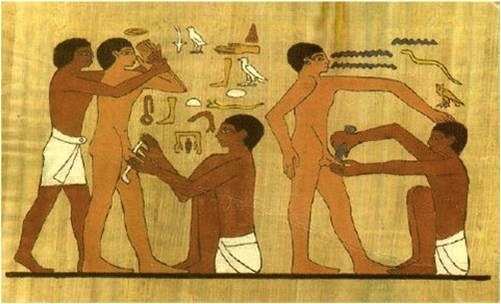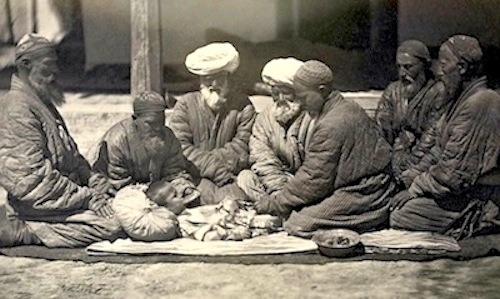
“Circumcision” is a medical procedure performed on males: “the cutting away of all or part of the prepuce (the foreskin) of the penis.” Because of the evangelizing of Paul and other Jewish believers after Jesus’ resurrection in c. 30-35 AD, many of the very early Christians were Gentiles who were not circumcised. The Christianized Jews in Jerusalem believed all the new converts to this new Jewish sect had to be circumcised because it was an unbroken law of God from Abraham’s time to the present: “God said to Abraham….You are to undergo circumcision and it will be the sign of the covenant between Me and you. For the generations to come every male among you who is eight days old must be circumcised….Any uncircumcised male, who has not been circumcised in the flesh, will be cut off (like the foreskin) from his people; he has broken the covenant.” Genesis 17:9-14
Paul, the Apostle to the Gentiles, strongly disagreed that Gentile converts had to be circumcised and his view that a person is saved by Faith not by adhering to the Law finally prevailed at the Council in Jerusalem in c. 50 AD and most early Christians as well as Greeks, Romans and Barbarians were not circumcised.

The oldest depiction of circumcision comes from a bas-relief (above) in the necropolis at Saqqara in Egypt dating to c. 2400 BC. It was performed with a flint knife on young boys as a ritual transition from boyhood to manhood. As can been seen in the art, the penis was anointed with balm and bandaged after the circumcision. About 100 years later an Egyptian named Uha described his circumcision along with many other men and said he acquitted himself valiantly.
The Greek historian Herodotus (c. 490-425 BC), called the Father Of History, travelled all over the known world in order to gather information and histories of nations. He comments on circumcision and its origins:

“…the Colchians (near the Black Sea), the Egyptians, and the Ethiopians are the only races which from ancient times have practiced circumcision. The Phoenicians and the Syrians of Palestine themselves admit that they learned the practice from Egypt…and the Syrians…as well as their neighbors the Macronians (in Greece), say that they learned it only a short time ago from the Colchians (Black Sea inhabitants)….No other nations use circumcision, and all those who do are without doubt following the Egyptian lead. As between the Egyptians and the Ethiopians, I cannot say which learned from the other, for the custom is evidentially a very ancient one; but I have no doubt that the other nations adopted it as the result of their intercourse with Egypt, and in this belief I am strongly supported by the fact that Phoenicians who have contact with Greece drop the Egyptian usage and allow their children to go uncircumcised.” Herodotus, Histories 2.104
About two hundred years before Herodotus, Jeremiah (c. 626-580 BC), the Old Testament prophet, wrote about circumcision. He enumerates the people, including the Jews, who were known for circumcising their males in his day in his region:

“Behold, the days are coming, declares the Lord, that I will punish all who are circumcised and yet uncircumcised—Egypt and Judah, and Edom (southwestern Jordan) and the sons of Ammon (Jordan), and Moab (Saudi Arabia) and all those inhabiting the desert who clip the hair on their temples; for all the nations are uncircumcised, and all the house of Israel are uncircumcised of heart.” (Jeremiah 9:25,26) The Weeping Prophet declares true circumcision is circumcision of the heart, not the body. The Covenant with God is a mind and heart act, not a mere physical manifestation. He harkens forward 700 years to Paul’s view of circumcision in Romans 2:29: “ No, a person is a Jew who is one inwardly; and circumcision is circumcision of the heart, by the Spirit, not by the written code (the Law). Such a person’s praise is not from other people, but from God.”
In the Western world, circumcision has long been associated with the Jew Abraham (c. 2000 BC) and the Jewish people. It must be noted that during a famine in Judea, Abraham sojourned in Egypt in c. 2000 BC and became friends with the Pharaoh. (Genesis 12:10-20) Perhaps he learned about circumcision there. Because Abraham is the father of all who have faith in the one God and in His Son Jesus, the Messiah, (Romans 4:16) Christians revere Abraham and many have always circumcised their children. Jesus of Nazareth was circumcised:

“On the eighth day when it was time to circumcise him, he was named Jesus, the name the angel had given him before he had been conceived.” (Luke 2:21) But it was for over 2,000 years a Christian option not a Christian duty and the Christian Church has never required circumcision. The most dedicated to the custom are the Muslims and their Semitic brothers the Jews who both trace their ancestry back to Abraham. The Muslims come from Abraham’s son Ishmael and the Jews are descendants of Abraham’s son Isaac.

In the 1930’s c. 50% of the male newborns in America were circumcised. The number increased to 90% in the 1950’s and 60’s after doctors in the Armed Forces demonstrated the heath advantages gleaned from World War II. In the 1970’s it became popular among some not to circumcise male newborns, but research again confirmed the health benefits and circumcision has risen from 1988 until the present.—Sandra Sweeny Silver
